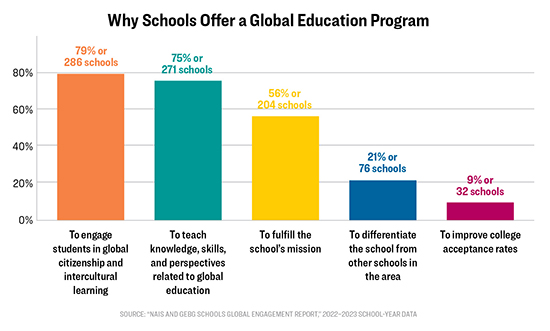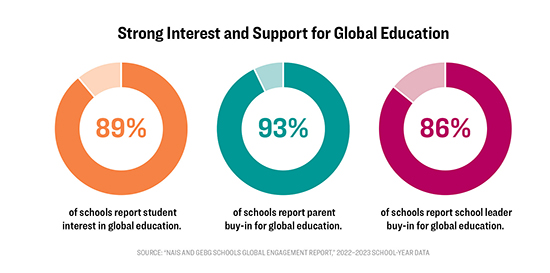 This article appeared as "Global Pursuits" in the Fall 2024 issue of Independent School.
This article appeared as "Global Pursuits" in the Fall 2024 issue of Independent School.The state of the world today feels uncertain in many ways—to adults and students. And for students in particular, the anxiety, confusion, and even fear they feel in response can be overwhelming. But it’s never been more important to understand the world and to learn how to engage in it. And global education, with its emphasis on helping students develop intercultural skills, such as listening across cultural and linguistic differences and embracing multiple perspectives, has never been more important.
Independent schools have long known this and have been embracing—and innovating—global education programs as a way to help students become well-rounded global citizens. Given this and the growing importance of global ed in a changing world, NAIS and Global Education Benchmark Group (GEBG) wanted to learn more about the trends in independent schools and the ways schools are teaching students and connecting with the world—through curriculum, learning experiences, partnerships, and more.
In fall 2023, NAIS and GEBG partnered to survey both organizations’ members—including global education directors and coordinators, heads of school, and assistant/associate heads of school who may or may not have a global ed role—to learn more about the trends in global education. The “NAIS and GEBG Schools Global Engagement Report,” conducted between November 2023 and January 2024, included 33 questions about the ways schools are connecting their students with global issues, perspectives, and competencies through curriculum, learning experiences, and partnerships across all areas of the school. Responses came from 494 participating schools (43% of which are members of both NAIS and GEBG). Day schools represented 78% of participating schools, while only 15% of schools reporting described themselves as boys’ schools or girls’ schools. Data were collected from all three divisions for the 2022–2023 school year.
The Findings
The survey focused on multiple dimensions of global education, including the purpose of global education, curriculum requirements and offerings, administration, travel programs, and funding and budget.
On-Campus Programs
Much of the survey was focused on on-campus or local learning, with schools indicating high levels of both co-curricular and curricular-related global education offerings. This focus on curriculum, on-campus programs, and close-to-campus immersive learning dispels the notion that global education at independent schools is primarily about international travel programs. Among the 371 respondents to the questions related to the type of programming offered, more than 65% reported offering globally focused student clubs, events, speakers or assemblies, and opportunities for students to engage locally with global issues (such as climate change, income inequality, and hunger) with various communities and partners.
Overnight Programming
As the pandemic started to subside, schools returned to off-campus overnight programming, recognizing the unique educational opportunities associated with immersive and experiential learning. Ninety-four percent of respondents offered school-sponsored overnight travel programs of two days or more, including at the middle school level (61%) and the primary school level (22%). Among those schools, 76% reported that they offered international travel programs at the high school level and 36% at the middle school level. While a majority of schools continue to offer these immersive learning experiences as enriching opportunities for select groups of students, many schools are bringing these experiences into the educational journey of every student with schools reporting the following requirements for all or almost all students: grade-level domestic overnight travel programs (49%), grade-level international travel programs (32%), and designated week(s) for off-campus or experiential learning (34%).
Courses and Curriculum
Schools are offering a wide range of ways that students can connect with global issues, understand multiple perspectives, and develop global competencies such as cognitive adaptability and intercultural communication skills. Out of the 356 schools reporting, 76% have a requirement that students take at least one globally focused course in high school. While most schools described this requirement as world history and/or world literature, other schools took a different approach: For example, one school said its high school students are required to choose at least one course from a set of globally focused social science courses with titles that include Challenge & Change, World Issues, Indigenous Perspectives, and Environmental Resource Management. Other schools reported requirements focused on leadership in today’s world; one school has an interdisciplinary course requirement called Global Leadership: Theory to Action, while another offers Critical Global Citizenship. These kinds of school-specific courses indicate that at least some schools are creating their own globally focused required courses for students beyond common offerings such as world history and world literature.
 In addition to world language courses, schools are creating curricula that focus on contemporary issues and themes, such as those among the United Nations Sustainable Development Goals (no poverty, zero hunger, climate action, quality education, and others). Some schools are creating structures and optional pathways for students who want to dive more deeply into global issues or intercultural skill development, with 23% of schools offering a structured global education diploma or pathway, and 39% offering courses with an embedded international travel component.
In addition to world language courses, schools are creating curricula that focus on contemporary issues and themes, such as those among the United Nations Sustainable Development Goals (no poverty, zero hunger, climate action, quality education, and others). Some schools are creating structures and optional pathways for students who want to dive more deeply into global issues or intercultural skill development, with 23% of schools offering a structured global education diploma or pathway, and 39% offering courses with an embedded international travel component.
Rationales and Resources
NAIS and GEBG schools reported a variety of reasons to pursue global education. When schools were asked to select their top two reasons for offering global education, almost 80% indicated that a primary reason was to engage students in global citizenship and intercultural learning. Seventy-five percent of schools indicated that a primary reason was to teach their students the knowledge, skills, and perspectives they see as related to global education, and more than 50% reported that they see global education as directly related to fulfilling their school mission. In a verbatim reply, one respondent said that it’s “because we live in an interconnected world which makes all education a form of global education.”
School Mission
A significant number of schools reported that global education is directly mentioned in their school mission statement or guiding documents (56%) and/or strategic plan (53%), offering further rationale for providing global engagement opportunities for every student. Likely in part because of these clear rationales, the data indicate that there is strong student interest (89%) as well as buy-in from parents (93%) and school leadership (86%).
Action Steps
Global education can take place anywhere, in a multitude of ways, and with students of any age. Many schools see global education as essential; one respondent commented on the “vital importance of global education in today’s world for today’s future leaders—our children.”
 With global conflicts and the lingering effects of the COVID-19 pandemic, independent schools have a great opportunity to help their students better understand and engage with the world around them. However, challenges will continue, such as insufficient staffing, a lack of clear program goals, and pauses on student travel programs.
With global conflicts and the lingering effects of the COVID-19 pandemic, independent schools have a great opportunity to help their students better understand and engage with the world around them. However, challenges will continue, such as insufficient staffing, a lack of clear program goals, and pauses on student travel programs.
Despite these challenges, schools must continue to commit to global education for the in-depth intercultural skill development it can provide. School leaders should focus on articulating the mission-centered learning outcomes they believe can be achieved by engaging their students with global issues, perspectives, and partnerships. Then, educators can design all learning experiences—from an assembly to a new curriculum unit or elective to an immersive learning experience beyond campus—toward those learning outcomes in developmentally appropriate ways. This provides clarity and cohesion to the range of globally engaged learning happening across a school as well as opportunities for innovation with a focus on these learning outcomes.
With learning focused on outcomes such as intercultural communication or understanding contemporary global events from multiple perspectives, schools committed to global engagement in today’s world have more clearly delivered on the aspects of their missions related to citizenship and leadership and have prepared their students for engagement beyond their campus now and in the future.
Go Deeper
For more data and analysis, including information about administrative structures, resource allocation, impact evaluation, and risk management for off-campus overnight programs, read the full “NAIS and GEBG Schools Global Engagement Report."Read More
Get more perspective on global education with these Independent School magazine articles:
- “Designing a Better Student Experience,” by Tim Fish, Fall 2023
- “Discourse Inflection: How to Teach Citizenship,” by Robert von Glahn, Fall 2022
- “Research Insights: Young Alumni Share Perspectives on Intercultural Learning,” by Clare Sisisky, Fall 2022
- “Creating a Global Learning Environment,” by Clare Sisisky, Fall 2019
- “When Global Education and an International Student Body Come Together,” by Jefferson Burnett and Ioana Suciu Wheeler, Fall 2019